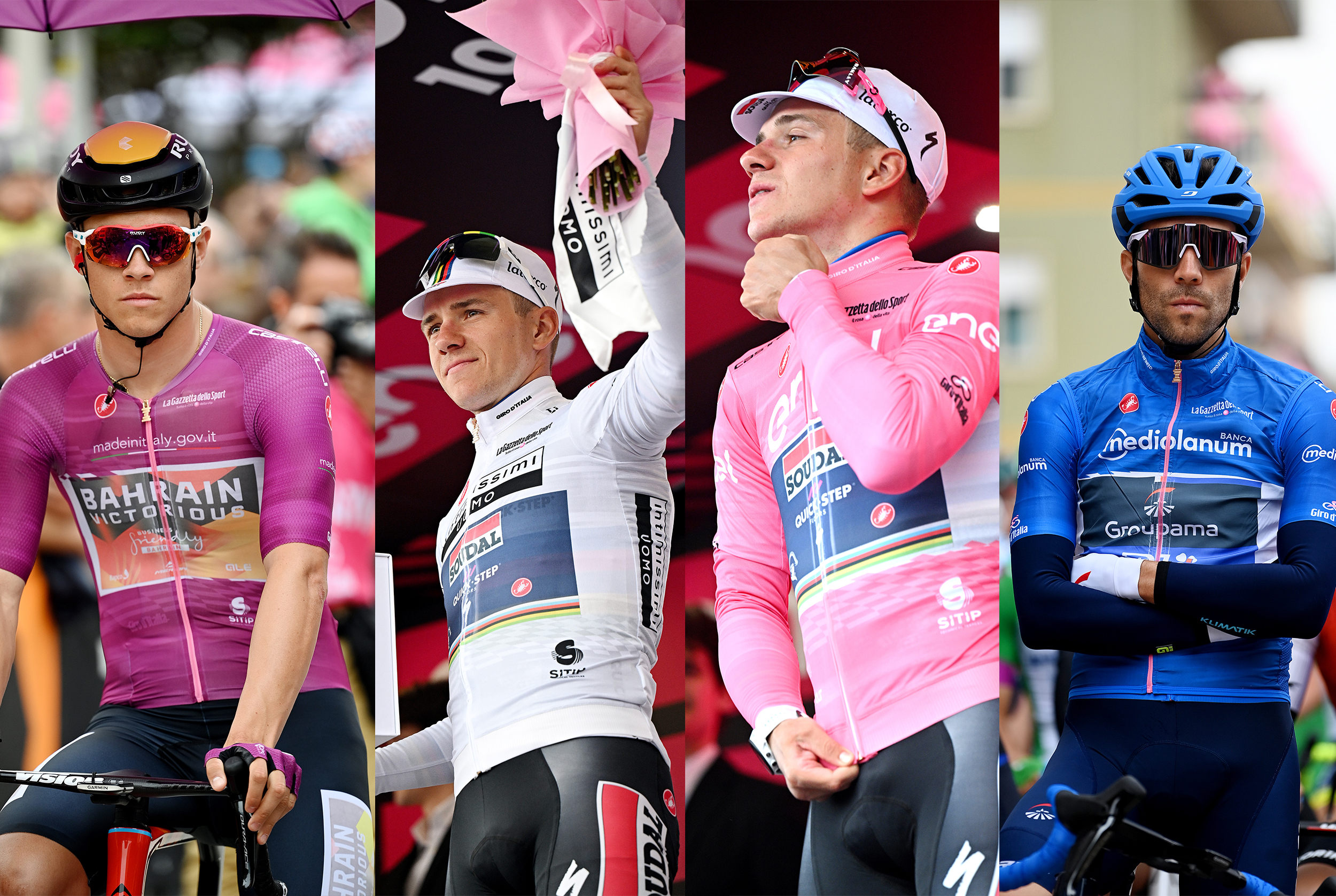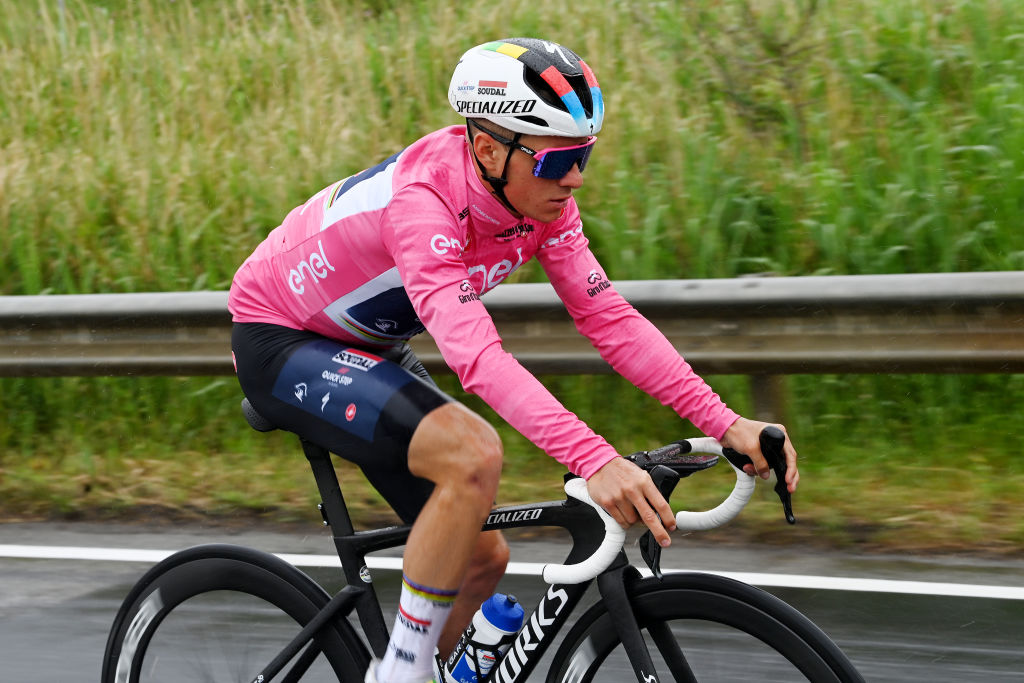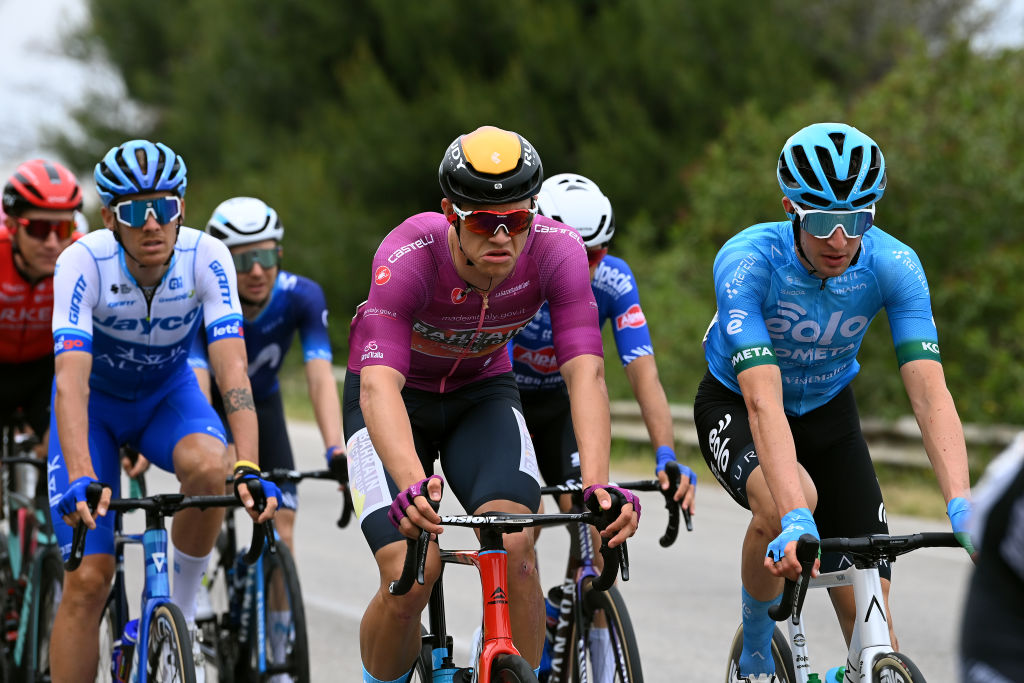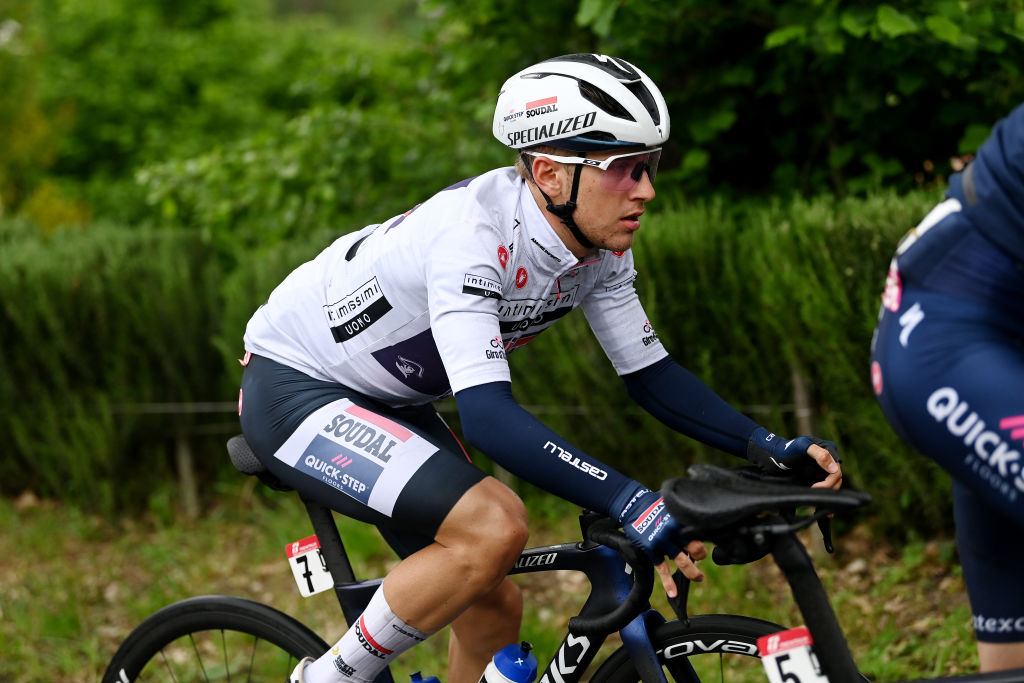
If you're watching the Giro d'Italia as intently as we are, then you might be wondering what all the distinctive jerseys mean. Away from the 22 different teams, and the national champions - and world champion, in the case of Remco Evenepoel (Soudal Quick-Step), there are four more jerseys you need to keep your eyes on.
They are the pink (rosa), white (bianco), purple/cyclamen (ciclamino) and blue (azzurra). That is the leader's jersey, the young rider's jersey, the points jersey, and the king of the mountains jersey, respectively. There's no Tour de France green or polka dots here.
The jerseys are all worn by the leaders in those competitions, unless one rider holds two at once - in that case, the pink jersey takes priority, followed by the ciclamino, then the blue and white. That's why you will see riders who are not leading the competition in the colourful jerseys.
There are also some other classifications that do not have distinctive jerseys that you should concern yourself with too, including the teams competition and the Cima Coppi.
Giro d'Italia jerseys
General classification - pink jersey

First up is the maglia rosa, the pink jersey, the kit worn by the leader of the general classification, the rider who has got around the route faster than everyone else. It is given to the rider who sits atop the GC at the end of every day, with the final one awarded with the Trofeo Senze Fine to the winner after the final stage.
It was introduced in 1931 and is pink because La Gazzetta dello Sport, the Italian sports newspaper which created the race, is printed on pink paper.
It is not as simple as getting round fastest cumulatively. Time bonuses are also on offer, with the top three men on each of the 18 road stages taking 10, six, and four seconds. Intermediate sprints on each road stage also offer bonuses of three, two, and one seconds.
In the event of two riders tying on time, the organisers will decide the standings based on fractions of a second measured in the race's time trials.
The pink jersey is sponsored by Enel, an Italian energy company.
Points - purple jersey

To be clear, the purple isn't purple, it's technically cyclamen, or ciclamino. This eye-catching kit is worn by the rider who has accumulated the most points over the stages.
Points on offer are weighted towards sprint stages, so flat or punchy stages offer more than summit finishes. An intermediate sprint on each day - apart from time trials - also offers points.
The 18 road stages of the race are separated into five difficulty categories with their own points weightings. On A and B category days, the top 15 score, while on others it is just the top 10.
A and B category (stages two, five, seven, 10, 11, and 21): 50, 35, 25, 18, 14, 12, 10, 8, 7, 6, 5, 4, 3, 2, 1 points
C category (stages three, four, six, and eight): 25, 18, 12, 8, 6, 5, 4, 3, 2, 1 points
D and E category (stages one, nine, 13, 15, 16, 18, 19 and 20): 15, 12, 9, 7, 6, 5, 4, 3, 2, 1 points
Intermediate sprints: 12, 8, 6, 5, 4, 3, 2, 1 points
The jersey is sponsored by the Italian Ministry of Foreign Affairs and the Italian Trade Agency to promote the country under the banner of BeIT.
Mountains - blue jersey
The blue jersey, or maglia azzurra, is given to the rider who takes home the most points on classified climbs over the race; potentially the best climber in the race, or the most canny breakaway expert.
There are 49 classified climbs across the 21 stages and unlike the Tour de France in recent years, it is not normally the GC winner who takes home the mountains jersey.
The mountain classification has appeared in the race since 1933 but a green was introduced in 1974. The jersey has been blue since 2012 to match the colours of the competition sponsor, the Milanese bank, Banca Mediolanum.
Climbs are separated into five different categories, from the Cima Coppi award to fourth-category. For the first time in 2023, summit finishes on first category climbs will gain extra points.
Cima Coppi: 50, 30, 20, 14, 10, 6, 4, 2, 1 points
First-category summit finishes (5 climbs): 50, 24, 16, 9, 6, 4, 2, 1 points
First-category (8 climbs): 40, 18, 12, 9, 6, 4, 2, 1 points
Second-category (18 climbs): 18, 8, 6, 4, 2, 1 points
Third-category (8 climbs): 9, 4, 2, 1 points
Fourth-category (9 climbs): 3, 2, 1 points
Best young rider - white jersey

The best young rider classification awards the white jersey. It is, in effect, the same as the pink jersey yet can only be won by those who were 25 or under at the start of the year. The current iteration of the jersey was introduced in 2007.
Italian men's underwear brand Intimissimi Uomo sponsors the jersey, which means that the holder every evening gets a pair of boxers with their jersey.
Evgeni Berzin, Nairo Quintana, Tao Geoghegan Hart, and Egan Bernal are the only men to win the pink and white jerseys in the same year, though Damiano Cunego would have been eligible had the prize existed in 2004. Remco Evenepoel would qualify if he won the overall this year.
Other classifications
Super team
This is the teams classification at any other race. The top three finishers from each team are added up each day, and then added up across the 21 stages, to establish the best team overall.
Lowest accumulated time wins, and there are usually some big gaps in this competition. It is sponsored by Autostrade per l'Italia.
Intermediate sprints
There are two intermediate sprints on each road stage, with both offering points towards this competition. It gives an opportunity to riders who spend a lot of time in breakaways, but might not win stages, to win a prize.
Points are awarded to the first five riders across the line – 10, six, three, two, and one.
Breakaways
The Fuga Pinarello prize is given to the rider who spends the most time in front of the peloton across the three weeks. Only breakaways of fewer than 10 riders are counted, and the move must cover more than 5km of racing.
Fighting spirit
This is essentially the Giro d'Italia's version of the Tour de France's 'supercombativity' award, and is incredibly subjective. A poll with a maximum of four riders will run each day from 7pm to 7am on the Giro d'Italia's Twitter. The winner gets a red number to ride with for the next day, and there is an overall winner at the end of the Grand Tour.
Fair play
Points are given to the squads which receive penalties across the 21 stages, and this is counted up over the race. The team with the least points wins. Simple.
Cima Coppi
The rider who crosses the highest point of the Giro d'Italia first is given the Cima Coppi, the prize named after Fausto Coppi, who won the race five times.
This year, the Cima Coppi is on stage 13, at the top of the 2,469-metre-high Colle di Gran San Bernardo.
MONTAGNA PANTANI
Another deceased Italian cycling great, Marco Pantani, is honoured by a separate mountain prize, the Montagna Pantani. It is given to the rider who tops another of the race's great climbs. This year, it's the Gran Sasso d'Italia on stage 7.







